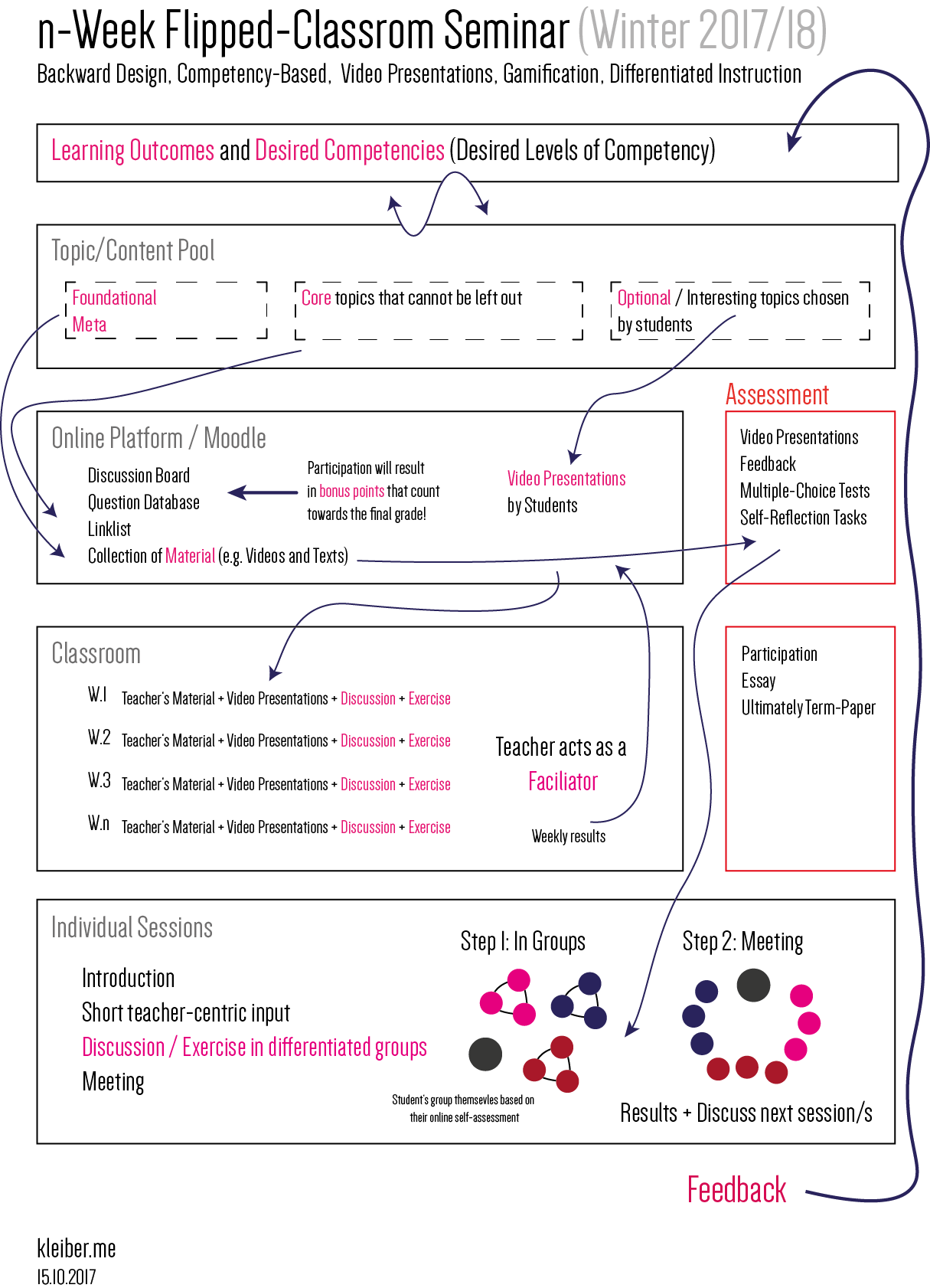Curriculum Design: n-Week Flipped-Classroom Seminar with Student's Video Presentations
Introduction aka. The Challenge
In this post I’m going to discuss one (my current) solution for a particularly difficult educational scenario.
I’m teaching an undergraduate class of about 40 students from (at least) two very different degree programs. Hence, besides the usual heterogeneity, there are significant ‘hard corded’ differences (previous classes taken; focus of their studies; career track; etc.) between the students taking the class.
Furthermore, I’m required to have them give a presentation and to write a term-paper - that’s predefined by the examination regulations. Since I want this to be a seminar - an educational space in which the students actually have a voice and engage in their own thought - forty participants pose a significant challenge.
My Current Solution
Naturally, I thought of a number of solutions. I set myself the following (minimum) requirements: The class should be based on…
- a competency driven backward design
- differentiated instruction as much as possible
- a feedback/data-driven approach
- at least some form of gamification
This is what I came up with:

Everything starts of with a set of learning outcomes and/or a set of desired competencies.
In terms of content/topics I conceptualized a ‘content pool’ that includes foundational/meta topics (e.g. How to take this class? How to learn? How to write a paper? How to produce a video?), core topics (i.e. topics/things that they definitely have to know), and optional topics which are of particular interest to the students. Obviously, this content pool interfaces with the learning outcomes and the two - at least to some degree - influence each other.
I designed this class based on the idea of a flipped-classroom (i.e. delivering the instructional content outside the classroom). Therefore, the online platform (Moodle in this case) plays a crucial role.
On Moodle, besides the actual material (i.e. videos produced by me, texts to read, etc.) the students have access to a discussion board, a question database, and a linklist. While the board is straightforward, the question database and the linklist serve as tools for the collaborative contsruction and organization of knowledge. Participation in this endeavor will be awarded with bonus-points that count towards the final grade.
Instead of regular presentations, the students will have to produce short (5 - 10 minutes) video presentations about one of the optional topics. These video presentation, at first, online ‘live’ inside the online platform and are peer-feedbacked by the other students. Ultimately, these video presentations serve as additional material in classroom sessions that have a relationship to the topic covered.
Following each week of online instruction, the students participate in an online assessment that is based on multiple-choice tests (knowledge) and self-reflection tasks about their own learning process and the content in general.
Moving over into the classroom, the results of these self-assessments serve as the basis for differentiated instruction. All classroom sessions (except the first and last one in the semester) are clearly focused on discussing (and exercising) a certain aspect of the overall topic. Usually, the overall topic of an individual week is determined by the core topics defined in the beginning.
During these sessions, the role of the teacher/instructor shifts towards being a facilitator who manages and supports the groups of students. These groups are, ideally, formed by the students themselves based on their self-assessments. They will work on different aspects and on different levels of complexity.
Each individual classroom session has a similar structure. After a quick introduction, there will be a short teacher-centric input in order to reactivate and reinforce the knowledge gained during the online part of the session. Afterwards, the majority of the sessions will be spent in smaller groups. Towards the end of the session, all student’s will meet again in order to discuss their results and to plan the upcoming session/s.
Since the final evaluation will be done in the form a term-paper (or essay), the students are invited to focus on a particular project or topic early on. This is especially supported through the option of choosing their own presentation topic which could act as the foundation for a later term-paper.
After each session and after the whole semester the students will provide feedback. This feedback then is used to inform/adapt both the initial learning outcomes and the topic pool for the upcoming semester.
What’s the reasoning behind all of this?
I believe that there are four major arguments in favor of this approach:
- The extensive group work, albeit sometimes exhausting, mitigates the fact that with forty people a participatory classroom discussion seems almost impossible.
- Relying on a flipped-classroom / blended learning approach will increase the overall workload, but it also will enable us to deal with wider array of topics while not compromising on discussions and or exercises and examples.
- Also, the blended learning approach combined with differentiated group work will help with mitigating the fact that the class is highly inhomogeneous.
- Using video presentations instead of ‘traditional presentations’ has the downside of robbing students the chance of presenting in front of the crowd. At the same time, however, with this number of students the only alternative to video presentations are group presentations which will take up large parts of each week’s sessions. Also, video-presentations will allow the students to experiment with a (hopefully) new medium and to create something long-lasting for their own portfolios.
Having said all of this, there are some potential downsides to this design. First of all, it puts a lot of responsibility into the hands of the students. Secondly, the added complexity makes teaching and planning these types of classes fairly complicated.
Well, “failure is always an option” (Adam Savage). Let’s not hold ourselves back because there is some chance of failure. Even in education some trial and erroris sometimes desperately needed.

Thank you for visiting!
I hope, you are enjoying the article! I'd love to get in touch! 😀
Follow me on LinkedIn